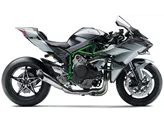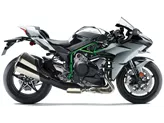Kawasaki Ninja H2 2015 vs. Yamaha R1 2015

Kawasaki Ninja H2 2015

Yamaha R1 2015
Vue d’ensemble - Kawasaki Ninja H2 2015 vs Yamaha R1 2015
The Kawasaki Ninja H2 model year 2015 and the Yamaha R1 model year 2015 are both high-performance supersport motorcycles that offer impressive power and performance. However, there are some key differences between the two bikes.
Starting with the engine and drive train, the Kawasaki Ninja H2 is equipped with a 998cc engine that produces 200 horsepower and 133.5 Nm of torque. It has a bore of 76 mm and a stroke of 55 mm, with a compression ratio of 8.5. The engine features four cylinders and four valves per cylinder, with a DOHC configuration. On the other hand, the Yamaha R1 also has a 998cc engine that produces 200 horsepower, but it has a lower torque output of 112.4 Nm. The R1 has a larger bore of 79 mm and a shorter stroke of 50.9 mm, resulting in a higher compression ratio of 13. Like the Ninja H2, the R1 also has four cylinders and four valves per cylinder with a DOHC configuration.

Kawasaki Ninja H2 2015
In terms of suspension, the Kawasaki Ninja H2 features a telescopic fork front suspension, while the Yamaha R1 is equipped with an upside-down telescopic fork front suspension. Both bikes have double disk front brakes and 17-inch front and rear tire diameters. The Ninja H2 has a front tire width of 120 mm and a rear tire width of 200 mm, while the R1 has a slightly narrower rear tire width of 190 mm. The Ninja H2 has a wheelbase of 1455 mm and a seat height of 825 mm, while the R1 has a slightly shorter wheelbase of 1405 mm and a taller seat height of 855 mm. The kerb weight of the Ninja H2 is 238 kg with ABS, while the R1 weighs 199 kg with ABS. Both bikes have a fuel tank capacity of 17 liters.
In terms of strengths, the Kawasaki Ninja H2 is known for its outstanding build quality and the fascinating engine with a mechanical turbocharger. It offers exceptional pull, acceleration, and speed, taking performance to a completely new level. The narrow seat ensures safe standing, even for smaller riders, and the bike offers great stability and inspires confidence despite its high performance. The Ninja H2 also has strong brakes and high-quality details.
On the other hand, the Yamaha R1 is praised for its crazy sound and rev-happy engine with a strong peak. It offers a great racing feeling in the saddle and comes with a superior electronics package. The R1 also boasts high-quality workmanship.

Yamaha R1 2015
However, both bikes have their weaknesses. The Kawasaki Ninja H2 has a response behavior in the transition from pushing mode to acceleration phase that is not at the level of "normal" motorcycles. It also experiences understeer in fast bends and may have integration issues for riders taller than 185 cm. On the other hand, the Yamaha R1 has torque sag in the middle and stability issues in the braking zone.
In conclusion, both the Kawasaki Ninja H2 2015 and the Yamaha R1 2015 are powerful and high-performance motorcycles with their own unique strengths and weaknesses. The Ninja H2 offers an exceptional engine with a mechanical turbocharger and great stability, while the R1 provides a thrilling racing experience and superior electronics. Ultimately, the choice between the two will depend on the rider's preferences and priorities.
Caractéristiques techniques Kawasaki Ninja H2 2015 par rapport à Yamaha R1 2015
Avantages et inconvénients en comparaison
Avantages et inconvénients en comparaison
Kawasaki Ninja H2 2015

La Ninja H2 représente une étape importante dans l'histoire de la moto. Elle est non seulement bourrée d'innovations électroniques, mais offre également des technologies totalement nouvelles en matière de construction de moteur et de mécanique. Cet objet de recherche high-tech d'un groupe technologique japonais est effectivement disponible à l'achat et peut être conduit. En principe, elle se conduit comme une moto normale, mais avec beaucoup plus de puissance. Au début, la réactivité du moteur est un défi, mais les amateurs de vitesse trouveront le moyen de conduire et d'apprécier cette moto fascinante.
Yamaha R1 2015

La nouvelle R1 est une grande réussite et n'a plus rien à voir avec le modèle précédent. Celle-ci était considérée comme une bonne moto de campagne et il fallait investir lourdement pour les excursions sur les pistes de course. Aujourd'hui, c'est l'inverse. La nouvelle R1 a été développée en mettant clairement l'accent sur les pistes de course. Le package électronique semble exceptionnel, les technophiles y trouveront leur compte. Les fans de Yamaha ne peuvent que sauter sur l'occasion, ils ont enfin une moto digne de ce nom. La R1 présente de légères faiblesses au freinage sur piste, où elle devient un peu instable. Ceux qui aiment acheter une moto de course prête à l'emploi, sans devoir travailler sur le châssis, ont intérêt à choisir la R1M. La suspension électronique d'Öhlins fonctionne à merveille et ne présente aucune faiblesse. Pour une utilisation purement sur circuit, il est également facile de corriger la deuxième faiblesse de la R1. Le trou de couple au milieu peut être facilement comblé par une nouvelle cartographie.
Comparaison des prix Prix moyen du marché Kawasaki Ninja H2 vs Yamaha R1
There are a few key differences between a Kawasaki Ninja H2 2015 and a Yamaha R1 2015. There are the same number of bikes of both models available on the 1000PS.de marketplace, specifically 4. It takes less time to sell a Yamaha R1 with 76 days compared to 153 days for the Kawasaki Ninja H2. Since model year 2015 1000PS.de editors have written 27 reviews for the Kawasaki Ninja H2 and 80 reviews for the Yamaha R1 since model year 2005. The first review for the Kawasaki Ninja H2 was published on 8/31/2014 and now has more than 5,600 views. This compares to more than 3,900 views for the first review on Yamaha R1 published on 4/28/2003.



















